If you are looking to have a healthy life by doing some ancient techniques then you must learn yoga. It is believed that people of ancient India used to practice yoga to keep their life and mind healthy. Many seals and fossil figures performing Yoga Sadhana were found near Indus Saraswati valley which suggest that yoga originated in India. The practice of modern yoga gained its popularity in western countries during the 1970s but the Yoga practice has been present in India since 5000 years back. “Yoga” the word derived from Sanskrit word ‘Yuj’ which means bringing harmony between mind and body. Yoga has many health benefits and this is supported by science too. There are many techniques and poses, practicing which you start enjoying a healthy life and fitness without even going into gym. Some Yoga techniques are so effective that they can even help you cure some critical illnesses. Among those Yoga Techniques, Twisting pose yoga has gained much popularity due to its effectiveness in our daily life. So to spread the knowledge of its effectiveness we have decided to write about the benefits of twist poses in yoga and how they actually work for our body.
What is Yoga?
In simple words Yoga is an ancient practice to keep our body and mind healthy by bringing harmony between them. The Yoga practices involve movement, breathing techniques and meditation to maintain the mental and physical health. Yoga is not only about practicing various poses but it also makes you learn discipline. According to a research conducted in 2020, the review shows that Yoga effectively helped adults to manage their stress level. Further, the 2014 review shows a promising result. In this study it was seen that 12 out of 17 people showed an improvement in physical or psychological measures related to stress.
What is Yoga Twist?
Yoga twist is a type of yoga in which you twist or rotate your torso in different poses depending upon twist type you want to practice. Twist changes the relationship of each vertebra which provides many health benefits.
Why Do You Need to Know about Twisting Pose Yoga?
The current generation mostly works in front of a computer or laptop sitting at the same place for long hours. This makes them lack in achieving required amount of mobility. This has become a problem for many young and middle aged people nowadays. When there is less amount of body movements, then this can cause digestion problems, back health issues and problems in blood circulation.
Since the problem has become so common among many, we decided to write about it, providing some solutions.
Body movements help your body to circulate blood, strengthen muscle, and bones. By practicing Twisting poses in yoga you help your body and abdominal muscles to achieve the required amount of mobility which letter on works as a remedy to the problems mentioned above.
Benefits of Practicing Twist Yoga
Twist poses help to gain space in hip, spine and shoulders which help in achieving muscle balance and coordination. By twisting the Spinal column this makes the back muscles to gain relaxation and helps reduce back pack. Different types of twist yoga poses work in different body parts which is beneficial for curing many different discomforts. Along with fixing back pain, twisting yoga is beneficial for improving digestion, nervous system, blood circulation, energy and many more. We have explained all the benefits individually below.
A Healthy Back
By practicing twist poses in yoga you help your spin to gain mobility. Twisting helps to restore and retain natural range of movement of the spine which reduces risk of joints hardening and fusing. Apart from strengthening the spine, twist poses also improve mobility and flexibility in the connective tissues/ muscles of the spine and become stronger which helps to reduce back pain. It has been recommended to practice twist yoga pose at-least twice a day to enjoy its full benefit.
Improves Digestion
Yoga twists create space in the body which allows your gut to pass through the foods. The movements during the twisting process create movement in the digestive system as well, the blood circulation and oxygen supply get boosted in the abdominal organs. The constant stretching and contracting of the abdominal muscle stimulate digestion and metabolism process. This also improves weight loss by improving detoxification and elimination of waste from the body.
Calms the Nervous System
There are many joints and ligaments in our spine which are highly enervated. Twist poses in yoga help them to calm by bringing them into proper alignment. Twist aligns spines which promotes relaxation of nerves and calms the nervous system. This releases the tension from the muscle and reduces stress from the body.
Boosts Energy
The lack of space in between vertebrae causes energy and life force (Prana) to get stuck which causes fatigue. The Twisting Yoga poses let you create space between vertebrae, connective tissue, and muscles that creates more room for breathing and maximizes the energy flow.
Improves Breathing
Twisting encourages deeper breathing. Everyday practice of deep breathing can increase the oxygenation in the lung and improve its capacity. The deeper breathing clears out toxins and mucus from the chest and lung which reduce the risk of diseases caused by chest infections.
Different Types of Twist Poses in Yoga
There are different types of twist poses in yoga and this can range from gentle stretch for beginners to advanced level which becomes more challenging slowly. These different types of poses in this yoga are used to provide relief in different body parts and benefit your overall health condition. Since the different poses offer different benefits, pick the right one that works for your body effectively.
Bharadvajasana:
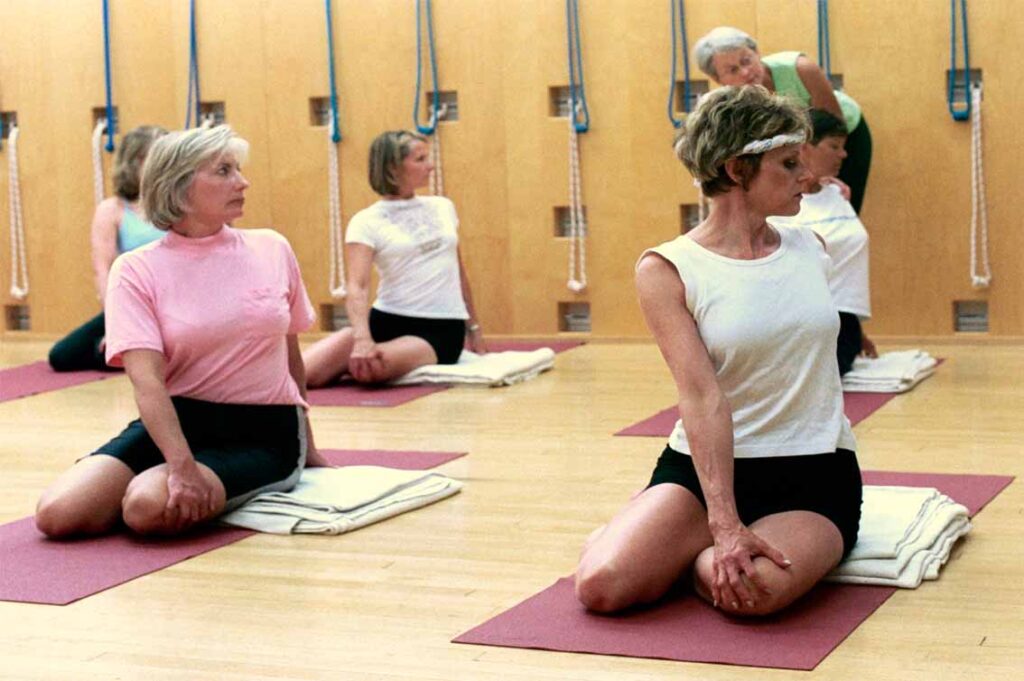
- Sit down on the floor and bend your knees to the right and shift your feet to the left. Your left ankle should be stacked on the right foot.
- Then put your body weight to the right buttock so that you can twist your spine easily.
- Inhale to lengthen the spine and slowly twist to the right with the help of your arms on the exhalation.
- Lastly, along with the twist of your torso, firmly turn your head and neck to the right.
- Place your left hand on your keen and right hand on the floor behind you for better support.
- Inhale on lengthening the spine and exhale when twist.
- You need to stay in this position for a few breaths and then you can switch to the other side.
- Repeat this for a few minutes.
Parivrtta Utkatasana:
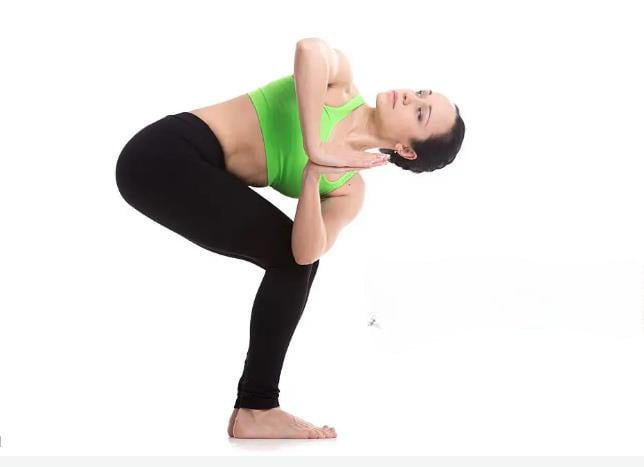
- Stand tall and bring both the feet together.
- Inhale and lift your arms above your head.
- Then exhale while you bend your knees and lower your hips down.
- Shift the weight into your heels and take a pose like sitting on a chair.
- Bring your hands together in front of your heart keeping them in Anjali mudra.
- Lift your chest and tuck tailbone.
- Exhale initiating movement from core.
- Twist torso to the left and put your right elbow to the outside of the left thigh.
- Don’t change the position of your lower half of the body.
- Bring the Gaze up to the sky and start breathing deeply.
- Hold for a few seconds and repeat it to the other side.
Marichyasana (Marichi’s Pose):
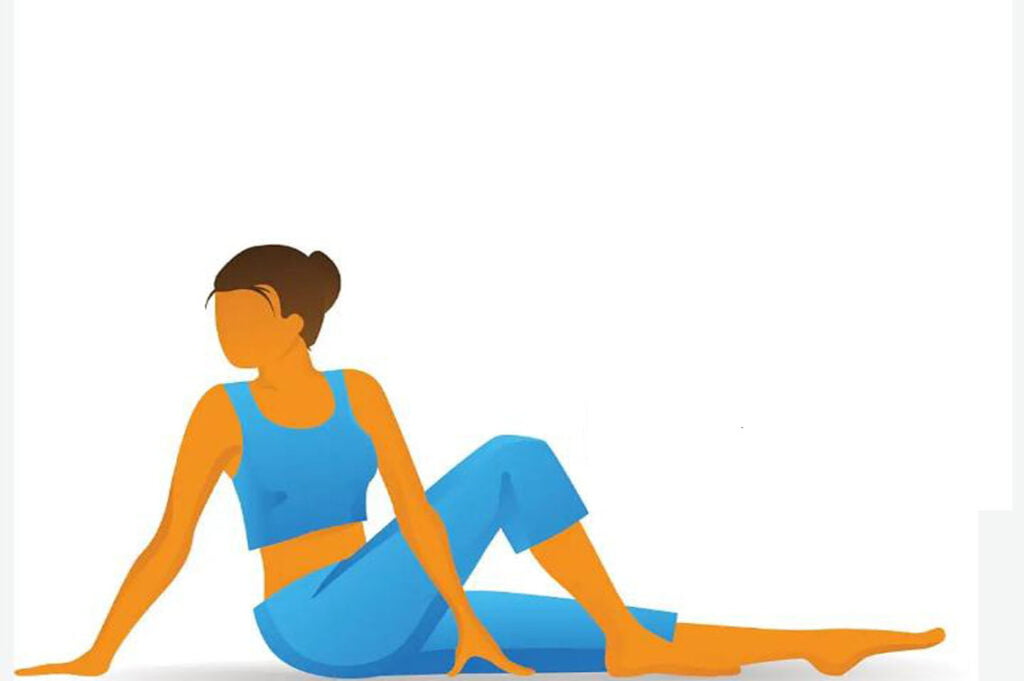
- Seat straight, keeping the legs extended in-front of you.
- Lengthen the spine from your tailbone to the crown of your head bend.
- Bend the right knee and place your foot down on the mat.
- Place your right hand behind you.
- Press the palm of your hand firmly on to the mat.
- Now, gently twist to the right bringing the left elbow outside of your right knee.
- Keep the left leg flexed and strong.
- Open your ribcage over your right shoulder.
- Inhale to lengthen the spine and exhale while rotating the spine.
- Stay in this position keeping the body twisted for about a minute.
- Release and come back to the normal position.
- Switch to the other side and repeat.
Parivrtta Trikonasana:
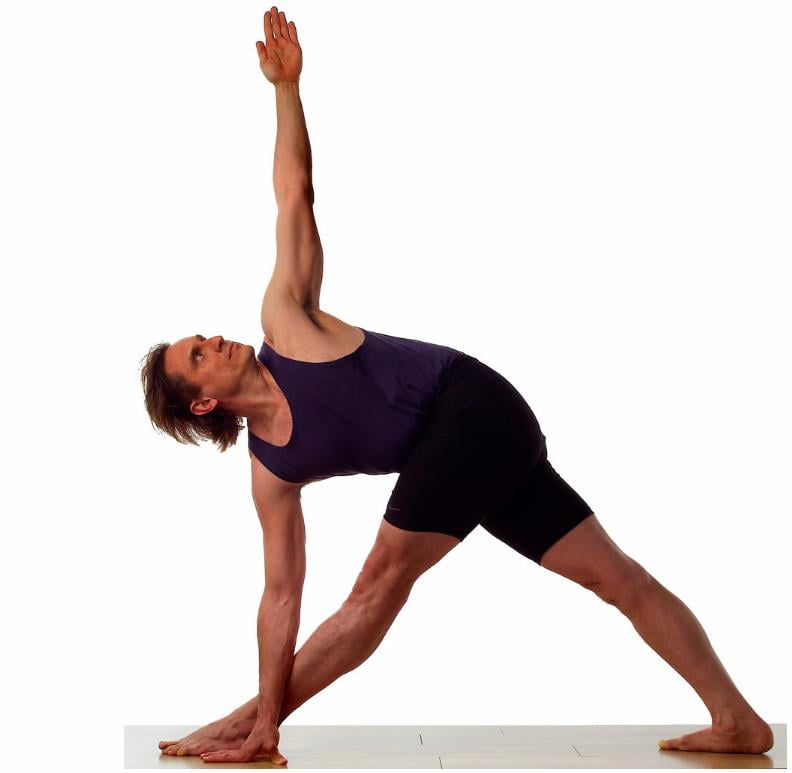
- Keep your feet parallel and knees locked.
- Take both of your legs apart from each other and maintain a gap in between them depending upon your height (Should be 4 to 4+ feet apart).
- Now turn your left foot in at around 45 degree angle and right foot out at around 90 degree angle.
- Balance your feet and get a solid grip while standing in the pose.
- Lengthen your spine, keep your chest open, lengthen your arms and inhale.
- Then slowly exhale and twist the entire body to the right.
- At this point inhale again and simultaneously lift your left arm up straight.
- Now, slowly exhale and bend towards your right leg and drop your palm in front of the foot.
- Inhale and then exhale with a further twist to the right and lift your right hand towards the ceiling.
- Keep opening the right shoulder.
- Stay in that position for about 30-40 seconds.
- Then inhale and slowly come back to the normal position.
- Switch side and repeat this.
Parivrtta Parsvakonasana:

- Stand straight and take both the legs apart from each other and keep a gap between them of around 4 feet.
- Raise both the arms.
- Turn your right foot on the right side.
- Lengthen your spine.
- Take both of your palms together in Namaskar mudra.
- Bend your right knee to the right at 90 degree angle keeping hip and thigh engaged and left knee lifted away from the floor.
- Now slowly turn your upper body to the right side and drop your left elbow on to the right knee.
- Try to twist your upper body furthermore and try to look up towards the ceiling.
- Hold the position for 5 to 7 breaths.
- Then come back to the normal position with an exhalation.
- Switch side and repeat this.
Ardha Matsyendrasana:
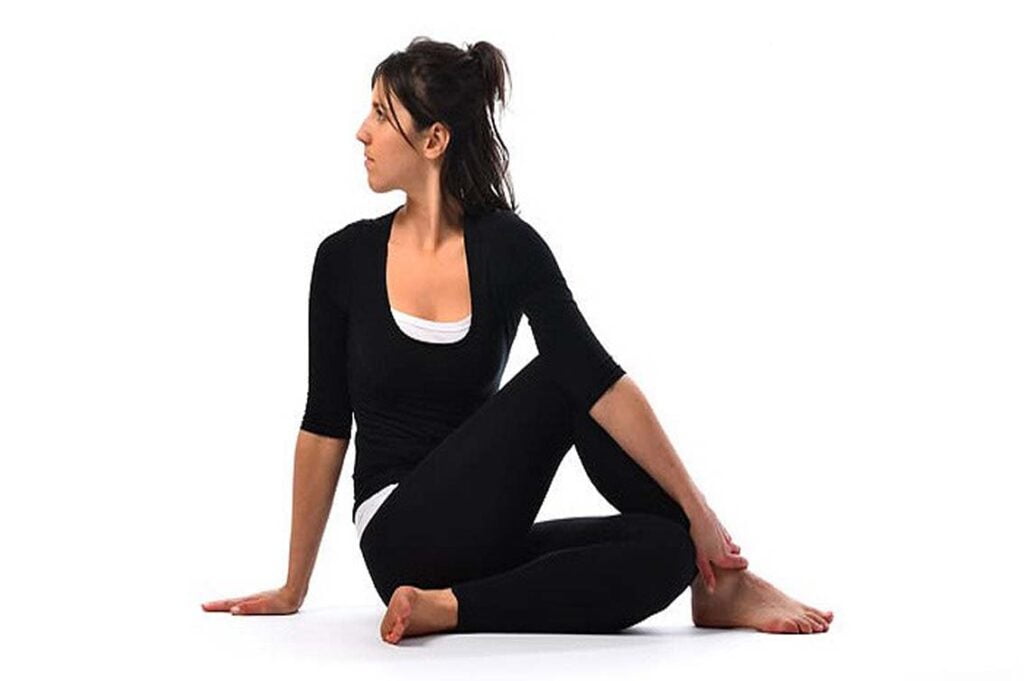
- Sit straight on the floor.
- Stretch your legs straight in the front.
- Raise both the knees and bend them.
- Bring the left knee down and bend the left lower leg beneath the right knee and place the boom leg (left leg) heal outside of the right buttock.
- Cross the right foot over your left thigh and place it on the floor.
- The left knee and right toe should be in one parallel line.
- Now, twist and place your right hand behind your back.
- Slowly bring the left arm over the right knee and catch the right ankle.
- Hold the position for 30-35 seconds and repeat that to the other side.
Jathara Parivartanasana:
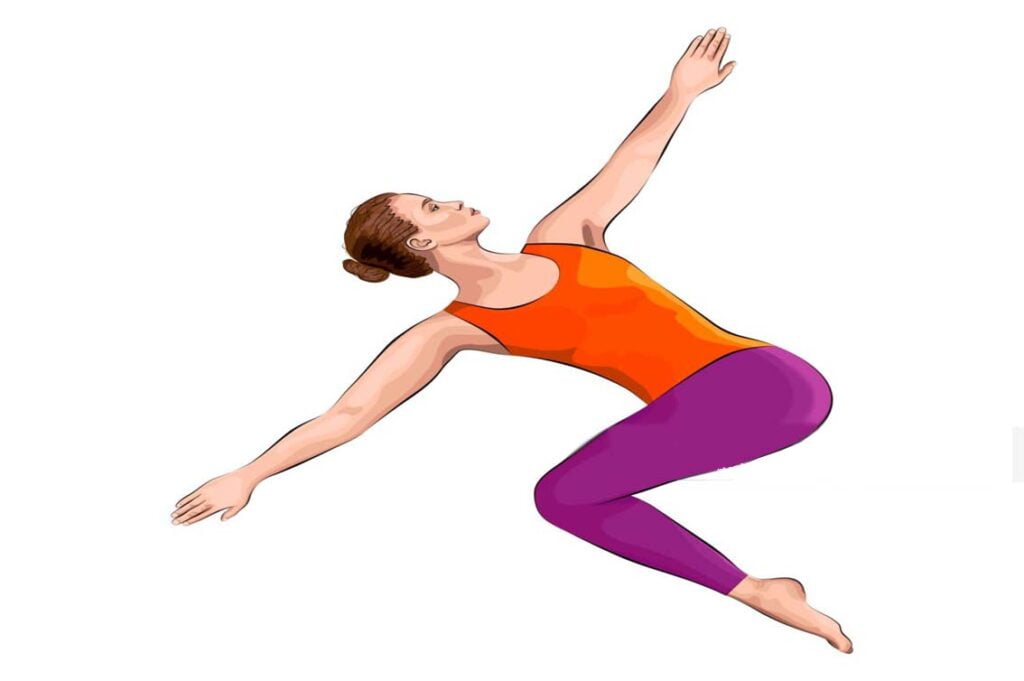
- Keep your back straight.
- Lie down on the floor with stretched legs.
- Drop your arms straight to the shoulder level.
- With an inhalation lift your knees and bend them together.
- Bring the legs as much as near to the chest keeping the posture same.
- Now, with an exhalation slowly twist your legs and abdomen to the right.
- Drop your legs on the floor.
- Keep the head straight and face towards the ceiling or you can twist your head to the left.
- Hold the position for a couple of breaths and repeat it to the other side.
- Do this a couple of times.
Who Should Avoid Practicing Twist Yoga Poses?
Pregnant Mom:
There can be a risk for pregnant women to practice yoga twists. Twist poses in yoga can cause them to feel uncomfortable too. This happens because of the excessive pressure that you put on the abdominal cavity at the time of twisting. This can be risky for the baby as well.
Digestive issues:
Yes, you read it right; twisting yoga can cause digestive issues some times. Practicing extreme twisting puts pressure on the intestines which worsen the gut-inflammatory symptoms and makes you experience digestive issues.
Joint issues:
The sacroiliac or the SI joint which is located in between pelvis and lower spine can destabilize due to extreme twist or incorrect practice of twisting pose. This can cause extreme pain in the joint. Hence if you are already experiencing pain in the SI joint or if you had pain in this area in the past then you must avoid practicing twisting yoga or consult with the doctor before practicing the twisting yoga.
A Person with Slipped Disc:
Bending, twisting, and lifting movements are not allowed if you have slipped discs. Twisting poses increase the pressure on the spine. This can cause damage to discs near the base and pain in the leg. Hence if you have slipped discs then you must avoid practicing twisting yoga poses.
Injury and Surgery:
People who earlier had hip, spine, shoulder, ankle or Knee injuries should avoid practicing twisting yoga. Also people who have undergone Cesarean birth surgery or any kind of abdominal surgery should avoid doing twisting yoga.
Twisting yoga poses are effective to manage many body concerns but this needs to be practiced with proper percussion and guidance. At the initial stage the beginners should start off with 2/3 poses and then slowly increase the count and duration of practice. Apart from enjoying the above mentioned benefits, practicing twist poses in yoga let you lose weight by reducing belly fat. Twisting poses squeeze the abdominal muscles, massage the organs which reduce fat in the belly area. At the time of practicing twist poses in yoga you must lengthen your spine, twist mostly from your upper and middle back. Last but not the least, to achieve safety while practicing the twisting poses it is important to achieve a stable foundation in your twist. I hope these tips would help you to enjoy practicing twist poses in a safest way.
For more information on health and wellness please visit our Blogposts.
